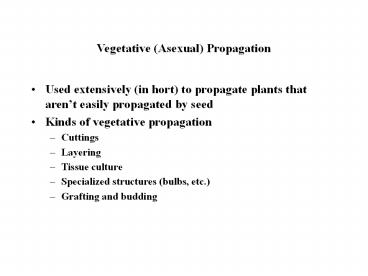Vegetative (Asexual) Propagation - PowerPoint PPT Presentation
Title:
Vegetative (Asexual) Propagation
Description:
Vegetative (Asexual) Propagation Used extensively (in hort) to propagate plants that aren t easily propagated by seed Kinds of vegetative propagation – PowerPoint PPT presentation
Number of Views:273
Avg rating:3.0/5.0
Title: Vegetative (Asexual) Propagation
1
Vegetative (Asexual) Propagation
- Used extensively (in hort) to propagate plants
that arent easily propagated by seed - Kinds of vegetative propagation
- Cuttings
- Layering
- Tissue culture
- Specialized structures (bulbs, etc.)
- Grafting and budding
2
All vegetative propagation methods use a piece of
one plant (propagule) to reproduce another
(identical) plantAll plants that are propagated
from one original plant are part of a clone
(clonal propagation)
3
Cuttings are (in general) the easiest, the
cheapest, and the most widely used forms of
vegetative propagationStem cuttings are the
most common type of cutting used
4
The goal in propagating by stem cuttings is to
replace the missing part (root system)Two
processes are required
- Dedifferentiation - the ability of a
differentiated cell to initiate cell division - Redifferentiation - formation of a growing root
5
Redifferentiation requires
- Cells competent to form a root meristem (root
initial) - Development of a root initial into a functioning
root (determinism)
6
Plants from which stem cuttings can be taken
- Annuals, biennials, herbaceous perennials (most
are easy-to-root) - Woodies (range from easy-to-root to hard-to-root)
7
Types of rooting on stem cuttings (based on the
type of roots that develop)
- Preformed roots and latent root initials -
present when the cutting is taken from the stem - Wound-induced roots - not present when the
cutting is made (cutting the stem into pieces
causes a wound reaction that stimulates rooting)
8
Preformed roots or latent root initials
- Develop while still attached to the parent plant
- Usually lie dormant till stems are made into
cuttings - Are often associated with nodes
- Are common in certain genera (e.g., Salix,
Hydrangea, Ribes, Populus)
9
Wound-induced roots (anatomical events)
- Dedifferentiation - differentiated cells prepare
to divide - Formation of root initials from dividing cells
- Root primordia formation - the apex becomes
organized - Root emergence through the stem
10
Both wound-induced and preformed roots are
adventitious
- New (de novo) growing points (root meristem) form
on established structures (e.g., a stem) - Roots arise other than by normal development of
the seedling - Or, simply - a root developing where one isnt
expected
11
Origin of adventitious roots in a stem
- Herbaceous near a vascular bundle
- Woodies
- Easy-to-root species (spp.) near the vascular
cambium directly - Hard-to-root spp. often requires an intervening
callus phase (indirectly)
12
Time of adventitious root formation in juvenile
and mature leaf-bud cuttings of Ficus pumila
treated with IBA
Davies FT et al. (1982) Amer J Bot 69804-811.
13
Callus and rooting
- Callus is an irregular mass of dividing
parenchyma cells - Relationship to rooting
- Formation of callus and roots are independent
events in easy-to-root spp. - Callus formation is often a precursor to root
formation in hard-to-root spp
14
From Fig. 9-10, Hartmann 2002
15
From Fig. 9-10, Hartmann 2002
Root Initials
apex organization
Root Primordium
differentiation, vascular connections
Root Emergence































